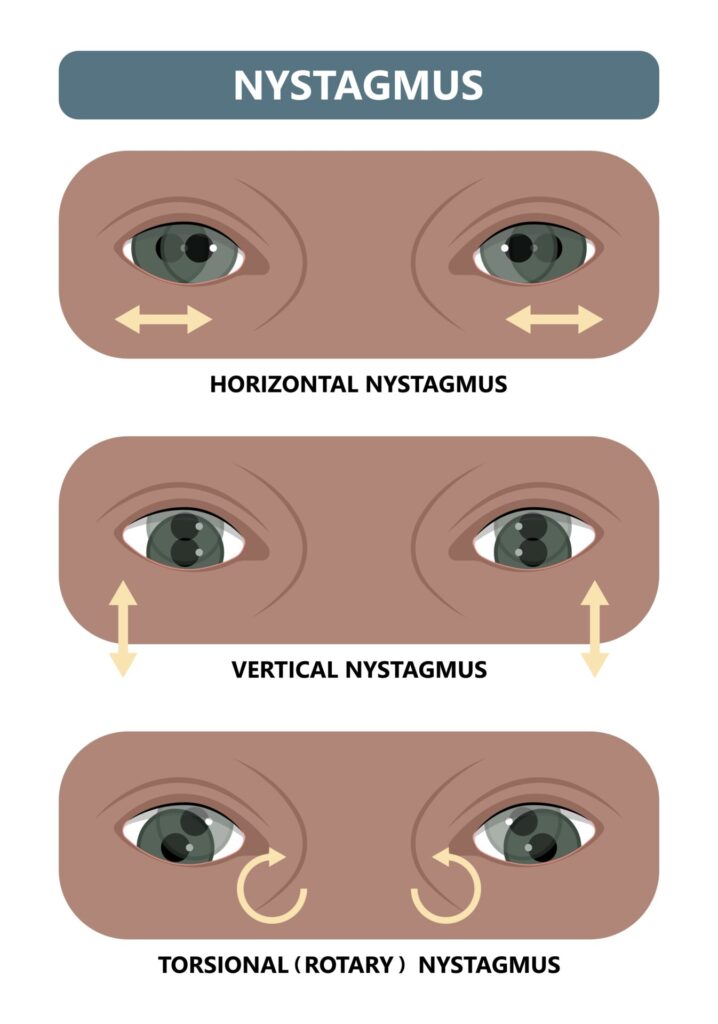Nystagmus is involuntary and rapid eye movement that could go from side to side, up and down, or around in a circular motion. It most commonly occurs in both eyes, and episodes can last for a period of seconds or can be a permanent issue.
Patients can be born with congenital (infantile) nystagmus, which usually appears before six months of age. Any development after six months is considered acquired nystagmus.
Congenital Nystagmus
Congenital nystagmus, also called infantile nystagmus, appears in babies during infancy and can occur as early as six weeks of age. Babies with nystagmus either have clear vision or an impairment wherein the eye cannot communicate clearly with the brain. If there is miscommunication from the eye to the brain and back, the eye will not be able to remain steady.

Congenital Sensory Nystagmus
Nystagmus due to impaired abnormal vision is sometimes called sensory nystagmus and is typically connected to other congenital issues like:
- Achromatopsia – a hereditary issue that causes the patient to lack color vision (they see in black and white) and have poor eyesight.
- Aniridia – a genetic issue that causes the patient to lack one or both irises.
- Cataracts – a genetic issue that causes the patient to have filmy or cloudy lenses at birth.
- Choroidal coloboma – a genetic issue that affects the inner eyeballs and causes reduced vision and a higher likelihood of experiencing a detached retina.
- Leber’s congenital amaurosis – a hereditary condition that affects the inner eye and results in severe vision loss.
- Oculocutaneous albinism – a genetic condition that affects the pigmentation of the skin, hair, and eyes.
- Optic nerve hypoplasia – a condition wherein the optic nerve is underdeveloped.
- Severe refractive error – A severe case of refractive errors like myopia, hyperopia, astigmatism, or presbyopia.
Each of these conditions leads to some level of visual impairment because the eye has difficulty sensing vision, thus lending itself to the name “sensory nystagmus.”
Congenital Motor Nystagmus
Babies born without the abovementioned conditions with nystagmus and normal vision typically have a neurological issue affecting motor control or the ability to steady the eyes. If their eyes dance around, they are usually tested for other related conditions, and if all tests are negative, they will likely receive the diagnosis of “congenital motor nystagmus.”
This is the most common type of nystagmus and tends not to have a clear and definite cause other than an ocular motor control issue.
Acquired Nystagmus
If nystagmus develops past the 6-month mark, it’s considered acquired and can occur for several reasons, including:
- Cancer development
- Strabismus
- Amblyopia
- Negative reaction to medication
- Vitamin deficiencies
- Injury or trauma
- Inner ear issues
- Stroke
- Brain tumor development
What are the Symptoms of Nystagmus?
The primary symptom of nystagmus is uncontrollable movement of the eyes and the feeling that the world around the patient is moving or shaking. Additional issues associated with nystagmus can include:
- Light sensitivity
- Poor nighttime vision
- Dizziness
- Lack of balance
Patients with congenital nystagmus or nystagmus that develops in early childhood tend not to see the world as moving or shaking; they often still see clearly other than some possible blurry vision (if they do not have significant vision loss). Adults with acquired nystagmus tend to report that their visual world appears to be shaking.
How Do You Treat Nystagmus?
Treatment can vary from patient to patient and depends on when nystagmus developed. While it cannot be cured, corrective eyewear like glasses and contacts can provide clearer vision and possibly help slow the eye down.
If a patient develops acquired nystagmus, sometimes the condition may fade on its own if the issue that caused it to develop is addressed.
In rare cases, surgery may be required to reposition the eye or eyes, but this is not a solution to cure nystagmus.
Who Diagnoses Nystagmus?
A skilled ophthalmologist, like the ones at Vision Eye Group, can assess the patient and determine if nystagmus is present. During the evaluation, they will look or test for related issues, such as cataracts, retinal complications, optic nerve issues, or strabismus.
Tests can include:
- Spin test – the patient spins for 30 seconds and then looks at an object. Nystagmus patients’ eyes will move slowly one way and then rapidly change directions.
- Eye movement recordings – recording the eye movement can help determine which type a patient has and their pattern of movement.
- Oscillating tracking test – the ophthalmologist will ask the patient to focus on an object while the doctor moves their head from side to side at random speeds to see if nystagmus is triggered.
There are additional tests the ophthalmologist may require the patient to undergo for a thorough evaluation.
Do you or your child suffer from rapid eye movements and think it could be nystagmus? Schedule an appointment with Vision Eye Group.
Whether you have started experiencing uncontrollable eye movements or you have noticed “dancing eyes” with your child, our ophthalmologists can help you with a thorough diagnosis and treatments for it should it be nystagmus. Schedule an appointment with our team today by calling 478-744-1710.
Recent Articles
